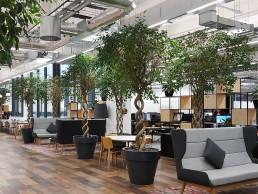
SLL publishes new office lighting guide
(UK) – The Society of Light and Lighting (SLL) has launched its latest Lighting Guide – LG7: Offices, with added consideration for hybrid working and the circular economy.
Expanding on its previous edition, published in 2015, the new guide addresses uncertainty around how office spaces will be sued in the future; with increased hybrid working and the use of portable devices meaning that people are spending less time in the office and more at home, the revised LG7 includes home office lighting advice.
Simon Robinson, WSP, author of LG7: Offices, said: “The future for the traditional office is looking increasingly uncertain. Change had already begun in the years before the Covid-19 pandemic, with people moving to laptops instead of desktop computers and, latterly, to tablets allowing increasing levels of flexibility in where they chose to carry out their work tasks. While it may not be suitable for everyone, many are choosing to redefine their working environment to include their homes for some of the time.
“The look, feel, and layout of office environments will always change to reflect how our lives change. The Covid-19 pandemic, however, is likely to be the catalyst for change on a scale hitherto unseen, making it a great time to be a lighting designer.”
For the first time, the guidance also includes a chapter focused on the impact of embodied and operational energy. This chapter discusses the general considerations that may apply to the amount of energy used by an office lighting installation, as well as the energy and carbon used in the manufacture and distribution of luminaires and the raw materials used to produce them. While proportions will vary between individual businesses, lighting represents a significant part of energy use, and this must be considered when designing an office lighting installation.
The guidance encourages the re-use of equipment where possible. Where luminaires are not suitable for reuse as complete units, it may be possible to have new control gear fitted into existing luminaire bodies, thereby avoiding the embodied energy used to manufacture new components. The SLL has produced TM66: Creating a circular economy in the lighting industry, which provides more detailed information on reusing existing equipment.
The illumination levels recommended by this guide reflect those in the British Standard for Light and Lighting – Lighting for Workplaces. It offers guidance that considers both the needs of individuals as well as the need to reduce energy use where reasonable. In the UK, office lighting levels should be provided at a level that is safe, comfortable and allows an individual to carry out their tasks efficiently. The approach may differ for each project based on several factors.
The approach reflected in the new LG7 is centred around a base level of illumination, which is then either increased or decreased following an assessment of the individual occupants and use of a space through the application of context modifiers. This can be seen as a significant change to how office lighting levels are determined if considered across the whole office space, rather than as a prompt to consider individual occupants or tasks.
More information about the SLL and LG7: Offices can be found here.



